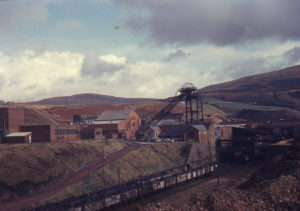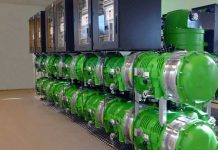Many bright minds are trying to harness renewables to decarbonise heat and deliver broader system benefits. The Energyst outlines some interesting projects taking place in the UK and Germany.
A weekend heat store
Chris Sansom is Associate Professor in Concentrating Solar Power at Cranfield University. His UK research focuses on novel materials for seasonal heat storage, most notably phase change (PCM) and thermo-chemical materials.
Interviewed for The Energyst’s 2016 Heat Report, Sansom outlined his belief that Magnesium Sulphate Heptahydrate, or Epsom salts, could be a viable material for seasonal heat storage. The idea is that adding water to the salts causes a reaction that creates heat at around 80 degrees C, which is viable for space heating and hot water.
However, Cranfield University’s energy and facilities management department has tasked Sansom with assessing whether he can deliver heat storage for the University’s growing campus, where heat demand is now more than its CHP system and biomass boiler can deliver.
20MWh: five-year payback

The project is to develop a 20MWh heat store that can store excess heat from the biomass boiler over the weekend, ready for the demand pick-up on Monday morning.
Because the system requires a specific temperature of 90 degrees C, Sansom will use a slightly different form of salt, Magnesium Nitrate Hexahydrate.
Sansom’s students have designed the storage tank – roughly a five-meter cube – and the initial assessment is that the system delivers a five-year payback. The next step is to take a more detailed proposal to the board. Sansom thinks it will go ahead, though potentially at a smaller scale.
“It kills two birds with one stone for the University, not only improving energy efficiency, but supporting their own research and students as well,” says Sansom.
“So I think it will go ahead in one form or another, and hopefully become a good demonstrator that heat storage can be achieved economically.”
Corrupted by power?
Asked why progress on decarbonising heat appears minimal, Sansom says it “isn’t necessarily a policy issue, more that we have just become so fixated by electricity that heat has been left out”.
He believes solar thermal, heat storage, heat recovery and heat networks sectors should “promote and market” the opportunities for renewable heat more aggressively – and may find the market more receptive now that the PV sector “is in a lull”.
Turning wind into heat

The system uses excess wind to create and store C02-free heat. The company claims the insulated heat store can then either provide process heat at 300-500 degrees C for industrial and commercial applications, lower temperature heat for district heating, or convert heat back to electricity to smooth peaks via a steam turbine.
Speaking at Aurora’s Spring Forum in March, Voigt told the conference that decarbonising process heat is a significant opportunity – 100TWh in Germany alone.
Hot rocks

Siemens Gamesa is also looking to deploy wind-powered heat storage, and says it will commission a 30MWh system based on 1000 tonnes of insulated ‘hot rocks’ at an aluminium smelter in Hamburg by spring 2019.
However, the firm plans to convert the heat back into electricity, with the government-supported project aiming to demonstrate renewable power can be stored more economically than traditional storage and be harnessed to provide power over a 24-hour period.
Mine water
Energy minister Claire Perry recently threw her weight behind projects to turn old mines into sources of renewable heat.
Speaking at a Westminster debate in March on energy efficiency and the Clean Growth Strategy, Perry said she is “really interested” in geothermal mine water technologies and offered encouragement to developers.
“If there are groups out there that are interested in promoting this and suggesting what can be done in a cost-effective way, bring it on,” said Perry. “We have already dug the holes [the mines], lets see whether we can get some more benefit for those communities.”

It comes as local authorities in old mining areas start to look at whether the pits can still provide community value. Bridgend County Borough Council has secured European funding to turn the old Caerau colliery into a source of renewable heat, while Nottingham City Council says it is starting to examine the potential of mine water.
Deep geothermal
Deep geothermal projects are also underway in the UK. They involve drilling deeper than traditional geothermal projects to extract higher temperature heat.

Geothermal Engineering Ltd (GEL) is currently involved in projects in Cornwall and Scotland. The United Downs project in Redruth, Cornwall, plans to drill down to 4.5km in order to extract water at around 190 degrees C. That would enable power generation as well as heat storage. Drilling is scheduled to commence in May.
The GEL project in Scotland, in partnership with Arup, gained planning permission in March and is set to commence drilling to a depth of 2km. The hot water extracted will be used to deliver heat to a network at the old Johnnie Walker bottling plant in Kilmarnock, which is being turned into a mixed-use development, called The Halo.
Fuel cells?
Fuel cells were supposed to be the next big thing in the mid-Noughties, but are taking some time to mature. However, West Sussex-based Ceres Power, backed by FTSE 250 firm IP Group, believes its technology, when operated as a CHP plant, could help decarbonise both heat and power.

The company completed a one-year small scale residential trial in September 2017, involving five houses in London and the South East. Ceres said the units provided most of the houses’ power (80% on average) and all of their hot water. It claimed the units save up to 2 tonnes of CO2 per household, with “near zero” NOx and SOx emissions. The fuel cells were connected to existing natural gas infrastructure, but can also take biogas or hydrogen where available, which would further reduce emissions.
The firm has joint development agreements with Nissan, Honda and Cummins for its solid oxide fuel cell technology.
This article forms part of The Energyst’s 2018 Heat Report. It will be available as a free download from Tuesday 17 April. The report contains views of end users around lower carbon heat, as well as industry experts about the challenges and opportunities in decarbonising heat.
The report and heat choices will be discussed at the Energyst Event, a free conference and exhibition taking place 17 & 18 April at the National Motorcycle Museum, Birmingham. Register for your free place here.
Related stories:
Eon boss: Renewable power is ‘done’, now for heat and transport
Energy minister Claire Perry: Bring on mine water heat projects
Tender launched for 3.15MW geothermal electricity plant
Nottingham County Council goes large on solar, eyes batteries, mulls mine water energy
Hydrogen for heat will create anchor carbon capture and storage projects
Heat networks ‘need regulation and a regulator’
Northern Gas Networks and ITM partner on power to gas storage
Climate Change Committee calls for ‘proper’ hydrogen trials
Waste heat a wasted opportunity
Can Epsom salts solve heat storage conundrum?
Click here to see if you qualify for a free subscription to the print magazine, or to renew.
Follow us at @EnergystMedia. For regular bulletins, sign up for the free newsletter.



